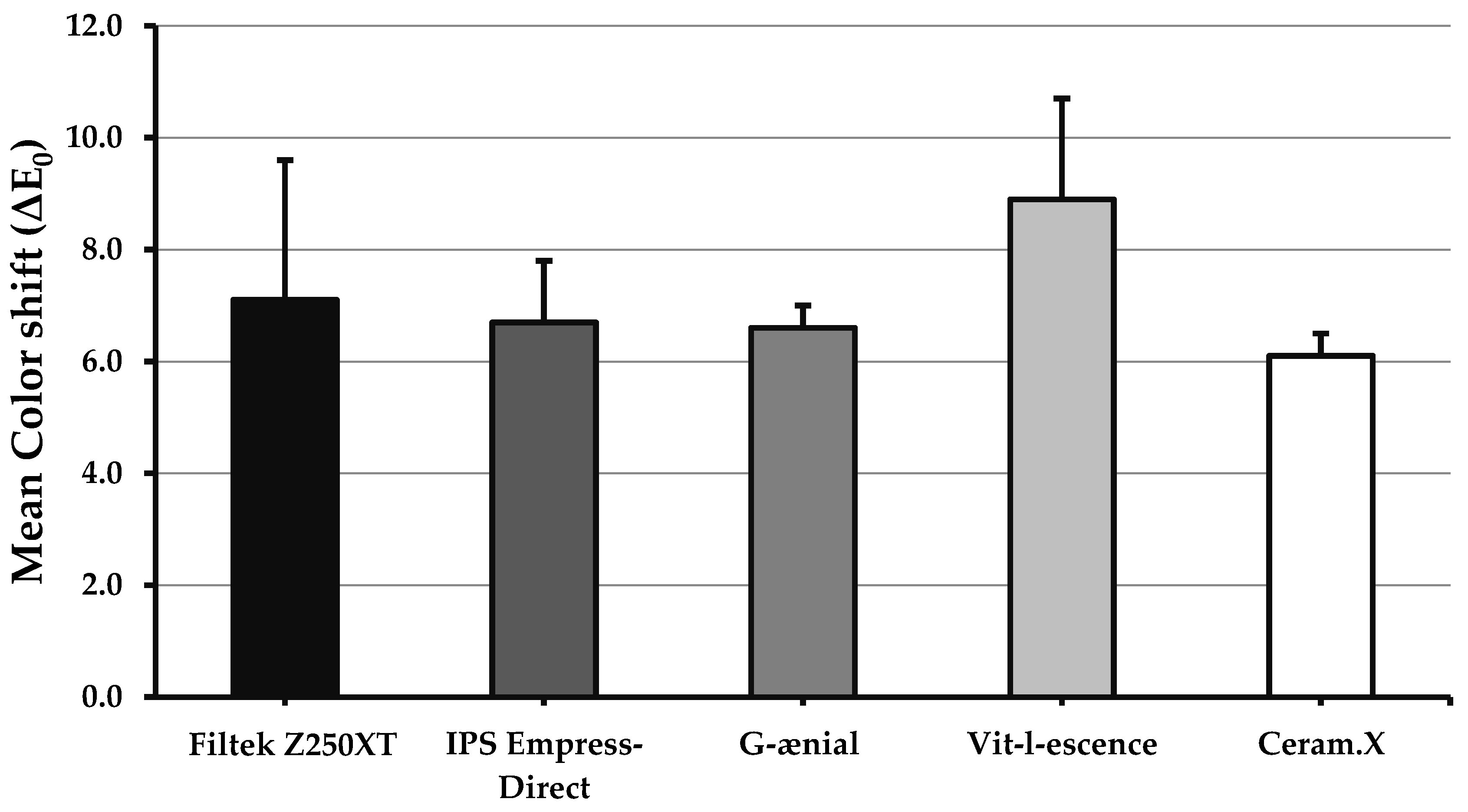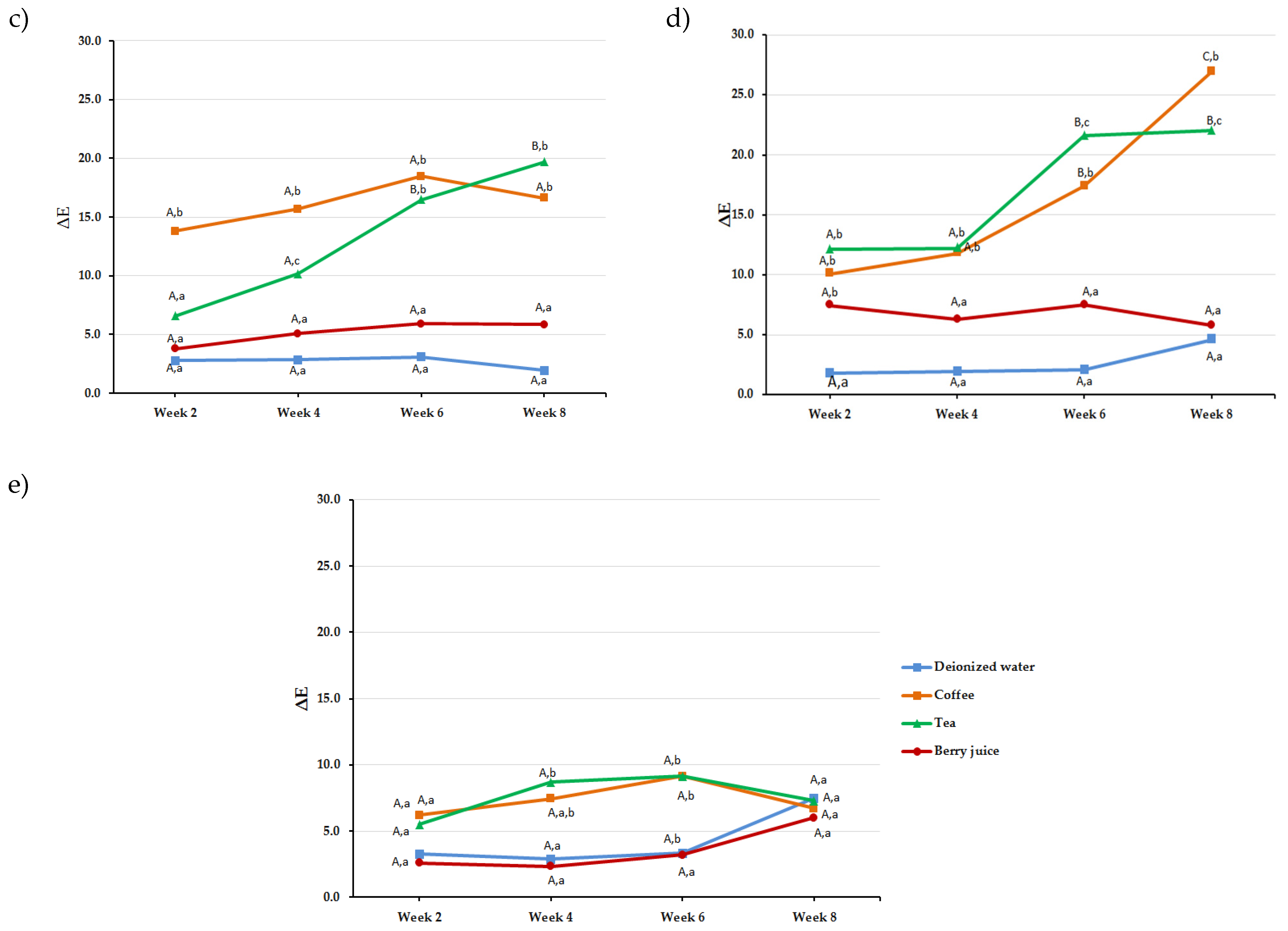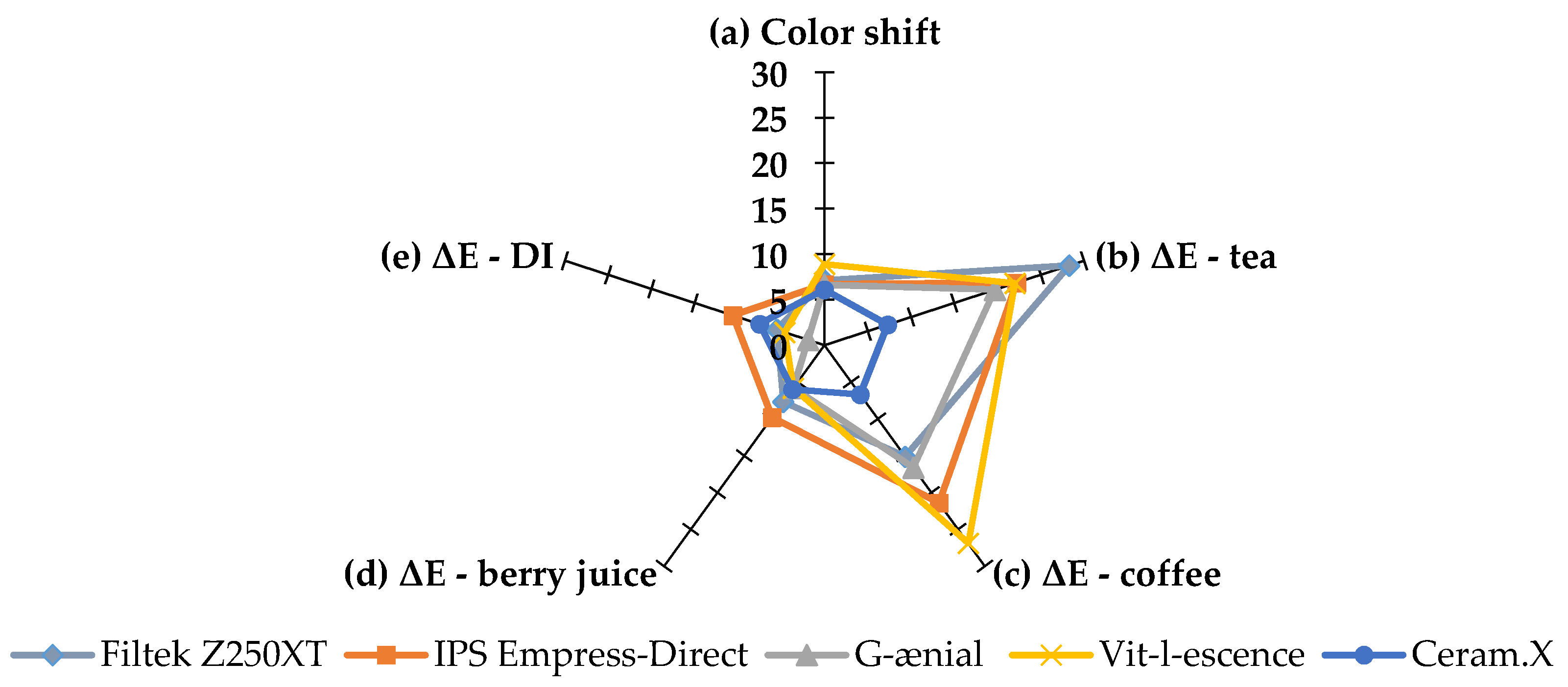Color Shift, Color Stability, and Post-Polishing Surface Roughness of Esthetic Resin Composites
Abstract
:1. Introduction
2. Materials and Methods
2.1. Specimen Preparation
2.2. Color Shift Determination
2.3. Staining Procedure
2.4. Color Stability after Storage in Beverages
2.5. Post-Polishing Surface Roughness
2.6. Statistical Testing
3. Results
3.1. Color Shift (∆E0)
3.2. Color Stability after Storage in Staining Solutions (∆E2 − ∆E8)
3.3. Post-Polishing Surface Roughness (Rq)
4. Discussion
5. Conclusions
Author Contributions
Funding
Acknowledgments
Conflicts of Interest
Abbreviations
| Bis-GMA | bisphenolglycidyl methacrylate |
| Bis-EMA | ethoxylated bisphenol-A dimethacrylate |
| PEGDMA | polyethylene glycol dimethacrylate |
| TEGDMA | triethylene glycol dimethacrylate |
| UDMA | urethane dimethacrylate |
| wt.% | weight percentage |
| vol.% | volume percentage |
References
- De Oliveira, D.C.R.S.; Souza-Júnior, E.J.; Prieto, L.T.; Coppini, E.K.; Maia, R.R.; Paulillo, L.A.M.S. Color Stability and Polymerization Behavior of Direct Esthetic Restorations. J. Esthet. Restor. Dent. 2014, 26, 288–295. [Google Scholar] [CrossRef] [PubMed]
- Van Ende, A.; De Munck, J.; Lise, D.P.; Van Meerbeek, B. Bulk-Fill Composites: A Review of the Current Literature. J. Adhes. Dent. 2017, 19, 95–109. [Google Scholar] [PubMed] [Green Version]
- Demarco, F.F.; Correa, M.B.; Cenci, M.; De Moraes, R.R.; Opdam, N.J. Longevity of posterior composite restorations: Not only a matter of materials. Dent. Mater. 2012, 28, 87–101. [Google Scholar] [CrossRef] [PubMed]
- Poggio, C.; Vialba, L.; Berardengo, A.; Federico, R.; Colombo, M.; Beltrami, R.; Scribante, A. Color Stability of New Esthetic Restorative Materials: A Spectrophotometric Analysis. J. Funct. Biomater. 2017, 8, 26. [Google Scholar] [CrossRef] [PubMed] [Green Version]
- Saraç, D.; Saraç, Y.Ş.; Külünk, Ş.; Ural, Ç.; Külünk, T. The effect of polishing techniques on the surface roughness and color change of composite resins. J. Prosthet. Dent. 2006, 96, 33–40. [Google Scholar] [CrossRef] [PubMed]
- Poggio, C.; Beltrami, R.; Scribante, A.; Colombo, M.; Chiesa, M. Surface discoloration of composite resins: Effects of staining and bleaching. Dent. Res. J. 2012, 9, 567–573. [Google Scholar] [CrossRef]
- Mundim, F.M.; Garcia, L.D.F.R.; Pires-De-Souza, F.C.P. Effect of staining solutions and repolishing on color stability of direct composites. J. Appl. Oral Sci. 2010, 18, 249–254. [Google Scholar] [CrossRef] [Green Version]
- Villalta, P.; Lu, H.; Ökte, Z.; García-Godoy, F.; Powers, J.M. Effects of staining and bleaching on color change of dental composite resins. J. Prosthet. Dent. 2006, 95, 137–142. [Google Scholar] [CrossRef]
- Mundim, F.M.; Pires-De-Souza, F.C.P.; Garcia, L.D.F.R.; Consani, S. Colour stability, opacity and cross-link density of composites submitted to accelerated artificial aging. Eur. J. Prosthodont. Restor. Dent. 2010, 18, 89–93. [Google Scholar]
- Ardu, S.; Braut, V.; Gutemberg, D.; Krejci, I.; Dietschi, D.; Feilzer, A.J. A long-term laboratory test on staining susceptibility of esthetic composite resin materials. Quintessence Int. 2010, 41, 695–702. [Google Scholar]
- Bahbishi, N.; Mzain, W.; Badeeb, B.; Nassar, H.M. Color Stability and Micro-Hardness of Bulk-Fill Composite Materials after Exposure to Common Beverages. Materials 2020, 13, 787. [Google Scholar] [CrossRef] [PubMed] [Green Version]
- Fontes, S.T.; Fernández, M.R.; De Moura, C.M.; Meireles, S. Color stability of a nanofill composite: Effect of different immersion media. J. Appl. Oral Sci. 2009, 17, 388–391. [Google Scholar] [CrossRef] [PubMed]
- Tjan, A.H.; Chan, C.A. The polishability of posterior composites. J. Prosthet. Dent. 1989, 61, 138–146. [Google Scholar] [CrossRef]
- Gupta, R.; Rai, R. In vitro evaluation of the effect of two finishing and polishing systems on four esthetic restorative materials. J. Conserv. Dent. 2013, 16, 564–567. [Google Scholar] [CrossRef]
- Karaarslan, E.S.; Bulbul, M.; Yildiz, E.; Seçilmiş, A.; Sari, F.; Usumez, A. Effects of different polishing methods on color stability of resin composites after accelerated aging. Dent. Mater. J. 2013, 32, 58–67. [Google Scholar] [CrossRef] [Green Version]
- Egilmez, F.; Ergun, G.; Cekic-Nagas, I.; Vallittu, P.K.; Lassila, L.V.J. Short and long term effects of additional post curing and polishing systems on the color change of dental nano-composites. Dent. Mater. J. 2013, 32, 107–114. [Google Scholar] [CrossRef] [Green Version]
- Bayne, S.; Schmalz, G. Reprinting the classic article on USPHS evaluation methods for measuring the clinical research performance of restorative materials. Clin. Oral Investig. 2005, 9, 209–214. [Google Scholar] [CrossRef]
- Johnston, W.M. Color measurement in dentistry. J. Dent. 2009, 37, e2–e6. [Google Scholar] [CrossRef]
- Rong, M.Z.; Zhang, M.Q.; Pan, S.L.; Friedrich, K. Interfacial effects in polypropylene-silica nanocomposites. J. Appl. Polym. Sci. 2004, 92, 1771–1781. [Google Scholar] [CrossRef]
- Gürdal, P.; Akdeniz, B.G.; Sen, B.H. The effects of mouthrinses on microhardness and colour stability of aesthetic restorative materials. J. Oral Rehabil. 2002, 29, 895–901. [Google Scholar] [CrossRef]
- Tian, F.; Yap, A.U.J.; Wang, X.; Gao, X. Effect of staining solutions on color of pre-reacted glass-ionomer containing composites. Dent. Mater. J. 2012, 31, 384–388. [Google Scholar] [CrossRef] [PubMed] [Green Version]
- Bueno, R.P.; Salomone, P.; Villetti, M.A.; Pozzobon, R.T. Effect of bleaching agents on the fluorescence of composite resins. Eur. J. Esthet. Dent. Off. J. Eur. Acad. Esthet. Dent. 2013, 8, 582–591. [Google Scholar]
- Tan, B.; Yap, A.; Ma, H.; Chew, J.; Tan, W. Effect of Beverages on Color and Translucency of New Tooth-Colored Restoratives. Oper. Dent. 2015, 40, E56–E65. [Google Scholar] [CrossRef] [PubMed] [Green Version]
- Theobald, A.H.; Wong, B.K.J.; Quick, A.N.; Thomson, W.M. The impact of the popular media on cosmetic dentistry. N. Z. Dent. J. 2006, 102, 58–63. [Google Scholar]
- Ren, Y.-F.; Feng, L.; Serban, D.; Malmström, H.S. Effects of common beverage colorants on color stability of dental composite resins: The utility of a thermocycling stain challenge model in vitro. J. Dent. 2012, 40, e48–e56. [Google Scholar] [CrossRef]
- Llena, C.; Fernández, S.; Forner, L. Color stability of nanohybrid resin-based composites, ormocers and compomers. Clin. Oral Investig. 2016, 21, 1071–1077. [Google Scholar] [CrossRef]
- Leite, M.L.; Silva, F.D.S.D.C.M.E.; Meireles, S.S.; Duarte, R.M.; Andrade, A.K.M. The effect of drinks on color stability and surface roughness of nanocomposites. Eur. J. Dent. 2014, 8, 330–336. [Google Scholar] [CrossRef]
- Johnston, W.M.; Kao, E. Assessment of Appearance Match by Visual Observation and Clinical Colorimetry. J. Dent. Res. 1989, 68, 819–822. [Google Scholar] [CrossRef]
- Ajay, R.; Kumar, M.S.; Sahib, S.A.M.; Chittrarasu, M.; Navarasu, M.; Ragavendran, N.; Mohammed, O.F.B. Color stability assessment of two different composite resins with variable immersion time using various beverages: An In vitro study. J. Pharm. Bioallied Sci. 2017, 9, S161–S165. [Google Scholar] [CrossRef]
- Hasan, A.K.; Sunarintyas, S.; Irnawati, D. Color stability of visible light cured composite resin after soft drink immersion. Dent. J. (Majalah Kedokt. Gigi) 2009, 42, 123. [Google Scholar] [CrossRef] [Green Version]
- Zidan, A.Z.; Mansouri, S.A. Effect of Water Sorption and Solubility on Color Stability of Bulk-Fill Resin Composite. J. Contemp. Dent. Pr. 2018, 19, 1129–1134. [Google Scholar] [CrossRef]
- Sideridou, I. Study of water sorption, solubility and modulus of elasticity of light-cured dimethacrylate-based dental resins. Biomaterials 2003, 24, 655–665. [Google Scholar] [CrossRef]
- Venz, S.; Dickens, B. NIR-spectroscopic investigation of water sorption characteristics of dental resins and composites. J. Biomed. Mater. Res. 1991, 25, 1231–1248. [Google Scholar] [CrossRef] [PubMed]
- Kerby, R.E.; Knobloch, L.A.; Schricker, S.; Gregg, B. Synthesis and evaluation of modified urethane dimethacrylate resins with reduced water sorption and solubility. Dent. Mater. 2009, 25, 302–313. [Google Scholar] [CrossRef]
- Tekçe, N.; Tuncer, S.; Demirci, M.; Serim, M.E.; Baydemir, C. The effect of different drinks on the color stability of different restorative materials after one month. Restor. Dent. Endod. 2015, 40, 255–261. [Google Scholar] [CrossRef]
- Malekipour, M.R.; Sharafi, A.; Kazemi, S.; Khazaei, S.; Shirani, F. Comparison of color stability of a composite resin in different color media. Dent. Res. J. 2012, 9, 441–446. [Google Scholar]
- Garoushi, S.; Lassila, L.; Hatem, M.; Shembesh, M.; Baady, L.; Salim, Z.; Vallittu, P.K. Influence of staining solutions and whitening procedures on discoloration of hybrid composite resins. Acta Odontol. Scand. 2012, 71, 144–150. [Google Scholar] [CrossRef]
- Karadas, M. The effect of different beverages on the color and translucency of flowable composites. Scanning 2016, 38, 701–709. [Google Scholar] [CrossRef]
- Ertaş, E.; Güler, A.U.; Yucel, A.C.; Köprülü, H.; Güler, E. Color stability of resin composites after immersion in different drinks. Dent. Mater. J. 2006, 25, 371–376. [Google Scholar] [CrossRef] [Green Version]
- Hossam, A.E.; Rafi, A.T.; Ahmed, A.S.; Sumanth, P.C. Surface topography of composite restorative materials following ultrasonic scaling and its Impact on bacterial plaque accumulation. An in-vitro SEM study. J. Int. Oral Heal. 2013, 5, 13–19. [Google Scholar]
- Pettini, F.; Savino, M.; Corsalini, M.; Cantore, S.; Ballini, A. Cytogenetic genotoxic investigation in peripheral blood lymphocytes of subjects with dental composite restorative filling materials. J. Boil. Regul. Homeost. Agents 2015, 29, 229–233. [Google Scholar]
- Sciammarella, C.A.; Lamberti, L.; Sciammarella, F.M.; Demelio, G.P.; Dicuonzo, A.; Boccaccio, A. Application of Plasmons to the Determination of Surface Profile and Contact Strain Distribution. Strain 2010, 46, 307–323. [Google Scholar] [CrossRef]
- Celik, C.; Yuzugullu, B.; Erkut, S.; Yamanel, K. Effects of Mouth Rinses on Color Stability of Resin Composites. Eur. J. Dent. 2008, 2, 247–253. [Google Scholar] [CrossRef] [Green Version]
- Pettini, F.; Corsalini, M.; Savino, M.G.; Stefanachi, G.; Di Venere, D.; Pappalettere, C.; Monno, G.; Boccaccio, A. Roughness Analysis on Composite Materials (Microfilled, Nanofilled and Silorane) After Different Finishing and Polishing Procedures. Open Dent. J. 2015, 9, 357–367. [Google Scholar] [CrossRef] [PubMed] [Green Version]
- Jung, M.; Sehr, K.; Klimek, J. Surface Texture of Four Nanofilled and One Hybrid Composite after Finishing. Oper. Dent. 2007, 32, 45–52. [Google Scholar] [CrossRef] [PubMed]
- Rocha, R.D.O.; Miotti, L.; Nicoloso, G.; Durand, L.; Susin, A. Color stability of a resin composite: Effect of the immersion method and surface treatments. Indian J. Dent. Res. 2016, 27, 195. [Google Scholar] [CrossRef] [PubMed]






| Material, Abbreviation | Category | Resin Matrix | Main Fillers Type and Size | Filler Load (wt.%/vol.%) | Manufacturer |
|---|---|---|---|---|---|
| Filtek Z250XT (Z250) | Nanohybrid | Bis-GMA, UDMA, Bis-EMA, PEGDMA, TEGDMA | Zirconia and silica (0.02–0.6 µm) | 78/68 | 3M ESPE, Dental Products, Saint Paul, Minnesota, USA |
| IPS Empress-Direct (ED) | Nanohybrid | UDMA, Bis-GMA, TEGDMA | Barium glass, ytterbium trifluoride, and mixed oxides (0.5 µm) | 75/52 | Ivoclar Vivadent, Zurich, Switzerland |
| G-ænial (GA) | Microhybrid | UDMA, dimethacrylate co-monomers | Silica, strontium, lanthanoid fluoride, fumed silica (0.1–17 µm) | 76/50 | GC Dental Products, Tokyo, Japan |
| Vit-l-escence (VL) | Microhybrid | Bis-GMA, TEGDMA | Silica (0.7 µm) | 75/52 | Ultradent Products, South Jordan, Utah, USA |
| Ceram.X (CX) | Nanoceramic | Methacrylate-modified polysiloxane, polyurethane methacrylate, Bis-EMA, TEGDMA | Barium-aluminum borosilicate glass, methacrylate functionalized silicon dioxide (0.01–1.5 µm) | 77/59 | Dentsply, Konstanz, Germany |
| Material | Solution | ΔE2 | ΔE4 | ΔE6 | ΔE8 |
|---|---|---|---|---|---|
| Filtek Z250XT | Tea | 8.9 ± 4.1 A,b | 12.1 ± 4.4 A,b | 24.0 ± 1.9 B,c | 28.3 ± 4.5 B,c |
| Coffee | 10.3 ± 2.2 A,b | 15.0 ± 5.7 A,b | 12.4 ± 4.5 A,b | 15.1 ± 3.0 A,b | |
| Berry juice | 3.5 ± 1.2 A,a | 3.7 ± 1.0 A,a | 4.1 ± 2.3 A,a | 7.7 ± 6.2 A,a | |
| Distilled water | 4.2 ± 6.5 A,a | 4.4 ± 6.3 A,a | 4.8 ± 4.7 A,a | 5.5 ± 7.6 A,a | |
| IPS Empress Direct | Tea | 17.6 ± 8.0 A,b | 22.2 ± 3.4 A,b | 23.6 ± 5.9 A,b | 22.2 ± 6.0 A,b |
| Coffee | 20.9 ± 4.9 A,b | 22.1 ± 2.4 A,b | 20.8 ± 4.8 A,b | 21.4 ± 2.9 A,b | |
| Berry juice | 6.5 ± 3.0 A,a | 7.0 ± 3.1 A,c | 8.1 ± 1.6 A,c | 9.8 ± 1.7 A,a | |
| Distilled water | 2.5 ± 0.6 A,a | 2.2 ± 1.2 A,a | 2.4 ± 0.5 A,a | 10.6 ± 5.5 B,a | |
| G-ænial | Tea | 6.6 ± 0.5 A,a | 10.2 ± 4.0 A,c | 16.5 ± 2.3 B,b | 19.7 ± 4.7 B,b |
| Coffee | 13.8 ± 0.6 A,b | 15.7 ± 1.9 A,b | 18.5 ± 1.1 A,b | 16.6 ± 0.9 A,b | |
| Berry juice | 3.8 ± 0.8 A,a | 5.1 ± 0.8 A,a | 5.9 ± 2.5 A,a | 5.8 ± 1.2 A,a | |
| Distilled water | 2.8 ± 0.5 A,a | 2.9 ± 1.0 A,a | 3.1 ± 0.9 A,a | 1.9 ± 0.7 A,a | |
| Vit-l-escence | Tea | 12.1 ± 6.8 A,b | 12.2 ± 2.4 A,b | 21.6 ± 7.2 B,c | 22.0 ± 6.9 B,c |
| Coffee | 10.1 ± 1.3 A,b | 11.8 ± 2.9 A,b | 17.4 ± 4.0 B,b | 26.9 ± 8.2 C,b | |
| Berry juice | 7.5 ± 4.7 A,b | 6.3 ± 4.3 A,a | 7.5 ± 4.9 A,c | 5.8 ± 3.7 A,a | |
| Distilled water | 1.8 ± 1.1 A,a | 2.0 ± 1.3 A,a | 2.1 ± 0.8 A,a | 4.6 ± 1.8 A,a | |
| Ceram.X | Tea | 5.5 ± 2.6 A,a | 8.7 ± 4.2 A,b | 9.2 ± 2.2 A,b | 7.3 ± 2.0 A,a |
| Coffee | 6.2 ± 3.2 A,a | 7.5 ± 4.2 A,a,b | 9.2 ± 1.8 A,b | 6.7 ± 4.3 A,a | |
| Berry juice | 2.6 ± 0.7 A,a | 2.4 ± 1.5 A,a | 3.2 ± 1.7 A,a | 6.0 ± 2.0 A,a | |
| Distilled water | 3.3 ± 1.5 A,a | 2.9 ± 1.1 A,a | 3.4 ± 1.0 A,a | 7.5 ± 1.3 A,a |
| Material | Solution | ΔL | Δa | Δb | ΔE |
|---|---|---|---|---|---|
| Filtek Z250XT | Tea | −1.3 ± 8.5 | −0.3 ± 2.1 | 27.3 ± 3.7 | 28.3 ± 4.5 * |
| Coffee | −10.2 ± 2.6 | 4.7 ± 1.8 | 10.1 ± 1.3 | 15.1 ± 3.0 * | |
| Berry juice | −3.4 ± 8.3 | 1.8 ± 1.0 | 4.2 ± 1.0 | 7.7 ± 6.2 * | |
| Distilled water | 4.7 ± 8.1 | 0.4 ± 0.3 | −1.0 ± 1.3 | 5.5 ± 7.6 * | |
| IPS Empress-Direct | Tea | −12.0 ± 9.1 | 2.0 ± 4.0 | 16.6 ± 4.8 | 22.2 ± 6.0 * |
| Coffee | −13.1 ± 3.9 | 5.9 ± 1.1 | 11.9 ± 2.5 | 21.4 ± 2.9 * | |
| Berry juice | 0.5 ± 6.0 | 3.3 ± 0.5 | 7.6 ± 1.1 | 9.8 ± 1.7 * | |
| Distilled water | 10.5 ± 5.4 | 0.6 ± 0.2 | −0.8 ± 0.9 | 10.6 ± 5.5 * | |
| G-ænial | Tea | −13.0 ± 5.4 | 5.6 ± 2.6 | 13.2 ± 1.5 | 19.7 ± 4.7 * |
| Coffee | −13.2 ± 1.0 | 4.1 ± 0.4 | 9.3 ± 0.5 | 16.6 ± 0.9 * | |
| Berry juice | −2.9 ± 1.2 | 2.0 ± 0.7 | 4.5 ± 1.3 | 5.8 ± 1.2 * | |
| Distilled water | 0.1 ± 1.4 | 0.2 ± 0.1 | −1.4 ± 0.9 | 1.9 ± 0.7 | |
| Vit-l-escence | Tea | −13.9 ± 9.8 | 4.7 ± 5.7 | 13.4 ± 5.8 | 22.0 ± 6.9 * |
| Coffee | −22.1 ± 9.8 | 7.2 ± 2.8 | 12.4 ± 1.6 | 26.9 ± 8.2 * | |
| Berry juice | 12.8 ± 20.6 | 0.6 ± 1.3 | 3.0 ± 3.5 | 5.8 ± 3.7 * | |
| Distilled water | 4.5 ± 1.8 | 0.1 ± 0.2 | 0.6 ± 0.6 | 4.6 ± 1.8 * | |
| Ceram.X | Tea | −2.8 ± 1.5 | 1.7 ± 0.5 | 6.5 ± 1.7 | 7.3 ± 2.0 * |
| Coffee | −4.8 ± 3.9 | 1.8 ± 0.9 | 4.1 ± 2.1 | 6.7 ± 4.3 * | |
| Berry juice | 4.0 ± 2.8 | 1.2 ± 0.4 | 3.7 ± 1.7 | 6.0 ± 2.0 * | |
| Distilled water | 7.4 ± 1.2 | 0.6 ± 0.2 | 0.3 ± 1.2 | 7.5 ± 1.3 * |
© 2020 by the authors. Licensee MDPI, Basel, Switzerland. This article is an open access article distributed under the terms and conditions of the Creative Commons Attribution (CC BY) license (http://creativecommons.org/licenses/by/4.0/).
Share and Cite
Alkhadim, Y.K.; Hulbah, M.J.; Nassar, H.M. Color Shift, Color Stability, and Post-Polishing Surface Roughness of Esthetic Resin Composites. Materials 2020, 13, 1376. https://0-doi-org.brum.beds.ac.uk/10.3390/ma13061376
Alkhadim YK, Hulbah MJ, Nassar HM. Color Shift, Color Stability, and Post-Polishing Surface Roughness of Esthetic Resin Composites. Materials. 2020; 13(6):1376. https://0-doi-org.brum.beds.ac.uk/10.3390/ma13061376
Chicago/Turabian StyleAlkhadim, Yara Khalid, Malak Jameel Hulbah, and Hani Mohammad Nassar. 2020. "Color Shift, Color Stability, and Post-Polishing Surface Roughness of Esthetic Resin Composites" Materials 13, no. 6: 1376. https://0-doi-org.brum.beds.ac.uk/10.3390/ma13061376





